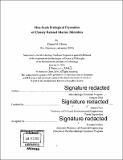Fine-scale ecological dynamics of closely related marine microbes
Author(s)
Chien, Diana M
DownloadFull printable version (16.28Mb)
Other Contributors
Massachusetts Institute of Technology. Department of Biology.
Advisor
Martin Polz.
Terms of use
Metadata
Show full item recordAbstract
Microbial dynamics in the environment are major drivers of global biogeochemical cycles; hence there is great interest in characterizing their rates and causes. While dynamics are affected by processes across many spatiotemporal scales, and even closely related microbes are known to vary in their ecological distributions, most work has characterized dynamics at bulk scales and with low genetic resolution. Thus, little is known about the effects of finer structure. In this thesis, I show that characterizing the dynamics of environmental microbes with finer spatiotemporal and genetic resolution reveals otherwise concealed dynamics. I use the Vibrionaceae, an ecologically diverse family of marine heterotrophs, as a model system. First, I review past studies on environmental associations of the Vibrionaceae, showing that few abiotic parameters have consistent predictive value, and that observed patterns vary based on taxonomic resolution. Biotic associations, however, may represent more specific predictors for fine-scale Vibrionaceae taxa, reflecting their diverse lifestyles. I then characterize Vibrionaceae dynamics within a high-resolution environmental time-series, with three months of daily sampling across four habitat partitions, population-level resolution, and large datasets of potential biological correlates. These data reveal diverse and spatially structured population dynamics. Individual populations varied from consistently abundant generalists to rare populations that occasionally displayed brief but intense peaks of abundance. Free-living and particle-attached habitat partitions were distinct in terms of diversity, turnover, and biotic interactors. These results emphasize the ecological differentiation of the Vibrionaceae populations, and the extent to which spatial partitions can function as distinct ecological regimes. Finally, I use sequence data from the Vibrionaceae populations to investigate a methodological question relating to phylogenetic resolution: how well does the standard taxonomic marker gene, 16S rRNA, resolve populations known to have distinct ecological distributions and dynamics? The analysis shows that even full-length 16S rRNA sequences collapse the majority of populations into only 2-3 taxa, concealing the breadth of ecological behavior within the family. Altogether, this thesis demonstrates that high resolution sampling techniques reveal a wealth of otherwise unobserved ecological diversity even within one family of closely related microbes, and suggests that fine-scale turnover and structure may have an unappreciated impact on microbial dynamics.
Description
Thesis: Ph. D., Massachusetts Institute of Technology, Department of Biology, 2016. Cataloged from PDF version of thesis. Includes bibliographical references.
Date issued
2016Department
Massachusetts Institute of Technology. Department of BiologyPublisher
Massachusetts Institute of Technology
Keywords
Biology.